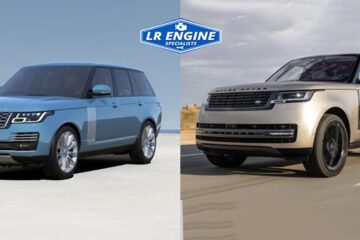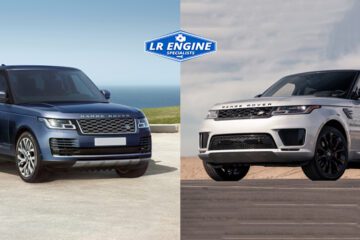When it comes to Range Rover engine comparison, the discussion often centers around two legendary models: the Range Rover Vogue 3.6 diesel and the Range Rover Sport SVR 5.0 petrol. Both vehicles promise a specific blend of luxury and performance, but they approach it in vastly different ways. The Vogue 3.6 diesel shines with its smooth, efficient power delivery and long-distance comfort, making it exemplary for those who value comfortable cruising. In comparison, the Sport SVR 5.0 petrol roars to life with explosive power and athletic agility, perfect for drivers wanting a thrilling driving experience. Each model offers its unique appeal, with the Vogue favoring refined sophistication and the Sport SVR providing dynamic excitement. Ultimately, the choice comes down to whether you prioritize the calm confidence of a diesel engine or the exhilarating rush of a petrol powerhouse, both epitomizing the Range Rover legacy in their unforgettable way.
Introduction to the Range Rover Engine Landscape
Range Rover engine comparison often begins by assessing their commitment to delivering dominant performance and comfort. Land Rover has always positioned the Range Rover range as a synthesis of luxury, capability, and engineering prowess. Two of the most notable engines in this range, the 3.6-litre TDV8 diesel and the 5.0-litre V8 Supercharged petrol, represent specific philosophies in both performance and audience targeting. Both variants are acknowledged in their own right, but they are designed according to vastly different demands.
Under the Hood: The 3.6 TDV8 Diesel Engine
The Range Rover Vogue 3.6 diesel engine was a breakthrough in diesel engineering for Land Rover. Introduced to handle the need for a torquey yet refined powerplant, this V8 engine is capable of generating 272 horsepower and a massive 640Nm of torque. With a twin-turbo configuration, this diesel engine was designed for long-distance comfort, smooth towing capacity, and superior fuel economy.
One of the distinct features of the 3.6 TDV8 is its ability to deliver maximum torque at low RPMs. This guarantees a smooth, responsive drive even under full load, making it desirable among those who use their vehicles for towing trailers, boats, or horseboxes. Despite being a diesel, it offers incredible acceleration and is extraordinaliy quiet for its class.
The engineering of the 3.6-litre diesel focuses on durability and longevity. It’s not more than just an engine; it’s a workhorse cloaked in refinement. The cast iron block, the latest fuel injection system, and powerful turbochargers contribute to an engine built to endure the toughest terrains and prolonged use without sacrificing driver comfort.
Inside the Beast: The 5.0 Supercharged V8 Petrol Engine
On the other hand, the Sport SVR’s 5.0‑litre petrol beast promises heart‑pounding performance and unsmashed aggression. This supercharged 5.0-litre V8 churns out a thrilling 567 horsepower and 700Nm of torque, making it the most robust engine ever fitted in a production Range Rover.
The SVR (Special Vehicle Racing) badge is a mark of performance brilliance. The 5.0-litre engine enables the Range Rover Sport SVR to accelerate from 0 to 60 mph in just 4.3 seconds. This level of performance brings it into the domain of high-performance sports cars while maintaining the commanding driving position and off-road capability of a typical Range Rover.
While the diesel Vogue is built for endurance and economy, the SVR’s petrol engine is designed for those who want velocity and exhilaration. The engine note alone, deep, aggressive, and thrilling, adds to the emotional experience of driving the SVR. Engineers at Land Rover’s Special Vehicle Operations have tuned this engine more than just for power, but for engagement and excitement.
Actual Performance Metrics
While conducting a Range Rover engine comparison, actual performance metrics matter. The Vogue’s diesel engine offers high-quality fuel economy at around 25 mpg, making it perfect for long-haul driving and those prioritizing cost-efficiency. Meanwhile, the SVR averages around 17 mpg, which shows its performance-first engineering.
In terms of torque delivery, the diesel’s benefit is in low-end grunt, providing max torque at just 2,000 RPM. The petrol SVR, in comparison, is maximum at higher RPMs but delivers a much more energetic acceleration profile, specifically above 3,000 RPM. This results in two very different driving experiences, one that is effortless and composed, and another that is raw and thrilling.
Driving Dynamics and Handling
Handling is another vital consideration in a Range Rover engine comparison. The Vogue 3.6 engine offers a stately, composed ride, excellent for motorway cruising and relaxed drives. Even rough roads feel refined, due to their impressive noise and vibration isolation.
The Range Rover Sport SVR benefits from a performance-tuned suspension and a lower centre of gravity, offering outstanding cornering ability and agility. For a vehicle of its size, the SVR’s responsiveness is amazing. Steering input is sharp, and body roll is minimal, attributes normally reserved for sports sedans.
Air suspension plays the basic role in ride quality for both models, but the tuning shows their distinct personalities, plush in the Vogue, performance-focused in the SVR. The Vogue’s setup prioritizes comfort, while the SVR’s system is stiffer and excellent for control at high speeds.
Towing Capability and Load Management
Handling is another vital consideration in a Range Rover engine comparison. The Vogue 3.6 engine offers a stately, composed ride, excellent for motorway cruising and relaxed drives. Even rough roads feel refined, due to their impressive noise and vibration isolation.
The Range Rover Sport SVR benefits from a performance-tuned suspension and a lower centre of gravity, offering outstanding cornering ability and agility. For a vehicle of its size, the SVR’s responsiveness is amazing. Steering input is sharp, and body roll is minimal, attributes normally reserved for sports sedans.
Air suspension plays the basic role in ride quality for both models, but the tuning shows their distinct personalities, plush in the Vogue, performance-focused in the SVR. The Vogue’s setup prioritizes comfort, while the SVR’s system is stiffer and excellent for control at high speeds.
Towing Capacity and Practicality
In practical scenarios, particularly when assessing Range Rover engine comparison, towing capacity and versatility are critical metrics. The 3.6 TDV8 diesel Vogue shines here, with a towing capacity of 3,500kg and torque delivery built specifically for load-bearing scenarios.
The SVR can manage, but it’s not designed for this kind of thing. Its petrol engine and stiffer chassis are not appropriate for heavy towing. It’s a vehicle meant for on-road thrills rather than utility-focused tasks.
Off-Road Prowess
Both vehicles come with Land Rover’s iconic Terrain Response system, allowing them to conquer various landscapes with ease. However, the diesel Vogue is more often favored for genuine off-road use due to its torque delivery, longer range, and more forgiving ride quality.
The SVR, while still capable off-road, is more likely to be kept on road, where its high-speed capabilities can be better admired. It lacks the low-end torque curve that makes the diesel engine so effective in rough, low-traction environments.
Maintenance, Reliability, and Cost of Ownership
Another fundamental factor in any Range Rover engine comparison is the long-term cost of ownership. Diesel engines like the 3.6 TDV8 are normally more fuel-efficient and can last longer if maintained properly. These engines, while robust and efficient, can demand higher repair costs due to their complex turbo setups and emissions gear.
Petrol engines, especially high-performance ones like the 5.0 SVR, typically need more frequent servicing and higher-quality fluids. The supercharger adds complexity and potential points of failure, but with meticulous care, these engines remain reliable.
Insurance premiums, road tax, and fuel prices are all higher for the SVR due to its performance stats and emissions. In comparison, the diesel Vogue tends to be more affordable overall, especially for drivers who log high mileage annually.
Resale Value and Market Perception
In today’s automotive market, resale value is influenced by various factors, including fuel type, engine performance, and brand perception. The SVR, being a front-runner performance model, enjoys strong demand among enthusiasts and collectors. Its resale value remains high, particularly for models in good condition with full service history.
The diesel market has been reshaped by stringent emissions laws and growing limitations in metropolitan areas. However, the 3.6 TDV8 remains eminent among those needing a potent, reliable, and luxurious diesel SUV. As such, it maintains a stable position in the pre-owned luxury SUV market.
Emissions and Environmental Considerations
With stricter emissions standards becoming the global standard, the conversation around Range Rover engine comparison must involve environmental factors. The 3.6 TDV8 diesel engine meets older Euro emission standards, which can be a disadvantage in cities with Low Emission Zones (LEZs).
The 5.0 SVR petrol engine, while less efficient in terms of CO2 emissions, often meets more recent benchmarks and may be less restricted in some urban environments. However, neither engine is a champion in terms of environmental impact, as both are large-displacement powerplants prioritizing performance.
Which Engine is Right for You?
Selecting between the Range Rover Vogue 3.6 diesel and the Range Rover Sport SVR 5.0 petrol ultimately comes down to your driving style, usage patterns, and personal requirements.
If you value long-range comfort, fuel efficiency, and workable performance, specifically for towing and off-road adventures, the diesel Vogue is an excellent choice. It’s a refined but capable SUV that shines in utility without compromising luxury.
On the other hand, if raw performance, on-road agility, and prestige matter more, the petrol-powered SVR is unparalleled. It’s a Range Rover that behaves like a sports car but still offers opulent interior features and off-road capability when needed.
Conclusion
When making a Range Rover engine comparison, understanding the main strengths and intended use cases of each variant is vital. The 3.6 TDV8 diesel in the Vogue champions utility, comfort, and fuel economy, while the 5.0 SVR petrol influences speed, thrill, and presence.
Both engines represent the peak of what Land Rover offers in their respective categories, and the right choice depends on what you want from your luxury SUV experience.
For expert insights and superior Range Rover engine services, visit LR Engine Specialists, your reliable authority in luxury 4×4 performance.
FAQs:
Which engine is more fuel-efficient: the 3.6 TDV8 diesel or the 5.0 SVR petrol?
The 3.6 TDV8 diesel offers better fuel economy at approximately 25 mpg, excellent for long-distance driving. The 5.0 SVR petrol averages 17 mpg, prioritizing performance over efficiency.
Which Range Rover is better for towing?
The Vogue 3.6 diesel is superior for towing with 640Nm of torque and a 3,500kg capacity. The SVR can tow, but it places more on speed than utility.
Is the SVR suitable for off-roading?
Yes, it has Terrain Response and off-road capability, but it’s improved for on-road performance. The Vogue diesel, however, is more appropriate for serious off-road use.
Which engine requires more maintenance?
The SVR’s supercharged petrol engine requires more frequent servicing and premium fluids. The diesel is reliable but can incur high repair costs if not maintained properly.
Which model holds better resale value?
The SVR holds powerful resale value due to its performance and enthusiast demand. The diesel Vogue remains valued for utility and longevity, specifically in rural markets.


